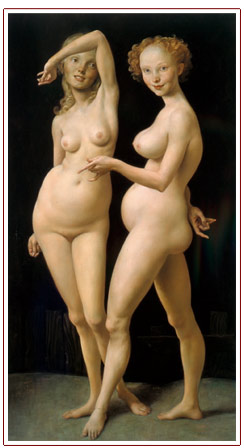On John
Currin Part 1 by Miles Mathis Michael Kimmelman drops many names in his article
(New York Times 11/21/03) on John Currin: Holbein,
Durer, Houdon, Goya, Pontormo, Mantegna, Carracci, and Van Eyck, among others. And while it is true that Currin has stolen
his compositions and poses from almost everyone (which used to be called lack
of imagination, although Currin, we are assured, is a painter of great
imagination) his paintings have nothing to do with any of these artists,
neither in style nor content.
Technically he may be marginally better than Hockney or Kitaj, but
comparing Currin to Holbein is a cruel joke upon them both. Currin has more in common with Fischl,
although he doesn't even achieve Fischl's nuancing—which is not meant as a
compliment to Fischl. In thinking of
the old masters, the following ideas come to mind: beauty, subtlety, depth,
power, true emotion. Conversely, we are
told that Currin excels in "cheap pathos", "vacant ritual images,"
and "fake sentiments." This
is all meant by Kimmelman to be high praise.
It is high praise because Koons and Richter are also masters of banality
and vulgarity, like Warhol and all the rest before them. Rich and famous guys, all. The message is clear: the tenets and
attitudes of Modernism are still very much alive, despite the supposed end of
Postmoderism, the rise of Pluralism, and the resuscitation of Realism. Serious art is still out of fashion, and
shallowness is still ascendant. What is
required is transparent recombination coupled with an aloof pose. A plastic technique propped up by an
imitation artist. An ersatz form
representing an ersatz idea created by an ersatz person. The people who matter in NYC are still fascinated
by the "vacuous and desperate", i.e. themselves. They gravitiate to "intentionally bad
painting" and "campy and debased subjects" since this leaves
open the very real possibilities that they can hope to be subjects of
well-known artists, or even the artists themselves (with the proper
promotion). Kimmelman says that "Currin seems to enjoy the mildly
creepy, fetishistic absurdity of his anachronistic women." And why should he not? He lives in big-city modern America; who
else is there? Although there is nothing "anachronistic" about the creepy absurd fetishism exhibited by Currin and his models, there is everything symptomatic about it. Like all the other
contemporary painters who think holding a mirror to the public's pathetic self
is artistically fascinating, Currin mimics its vulgarity, it squeals and
cringes, and then it runs to buy more mascara and tighter pants. Of course art-as-pathology remains on
top—to whom could art-as-subtlety-and-depth appeal to anymore? Where is the market? Poor librarians in Bangor or Bethesda don't
drive the economy. If
Currin's content is fake emotion, barbed wit, and cheap pathos, then he obviously
has more in common with someone like Bruce Nauman—yesterday's child—and his
technique is really beside the point.
Nauman and Hirst and countless others have proved that such content
requires no technical mastery at all. That
is why some people are confused by Currin: they wonder why he went to all that
trouble, just to give us the same old cleverly empty basket. Kimmelman tells us that "Eyes in Mr. Currin's work tend to be
black holes, sucking up light."
And even more specifically, "Mary O'Connell's eyes, flat disks, are
the emotional vortex of the picture."
And there is the contradiction that drives the mystery: how can vacuous eyes be an emotional vortex,
how can art be driven by a theory in which vacuity and banality are positive
virtues, and how can art history possibly be served by newspaper copy that
offers up such theory as the ne plus ultra of culture, as fascinating
fare for the educated and discerning reader? If this paper was useful to you in any way, please consider donating a dollar (or more) to the SAVE THE ARTISTS FOUNDATION. This will allow me to continue writing these "unpublishable" things. Don't be confused by paying Melisa Smith--that is just one of my many noms de plume. If you are a Paypal user, there is no fee; so it might be worth your while to become one. Otherwise they will rob us 33 cents for each transaction. |
